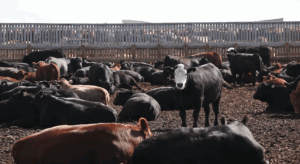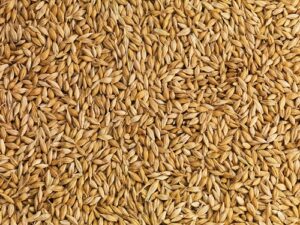Unwinding the Fiber in Finishing Diets🎙️
CLICK THE PLAY BUTTON TO LISTEN TO THIS POST:
Listen to more episodes on BeefResearch.ca, Spotify, Apple Podcasts, Amazon Music or Podbean.
This article written by Dr. Reynold Bergen, BCRC Science Director, originally appeared in the October 2025 issue of Canadian Cattlemen magazine and is reprinted on BeefResearch.ca with permission of the publisher.

High-grain feedlot finishing diets improve feed conversion efficiency and produce high-quality, well-marbled beef. Corn has traditionally been the dominant feed grain in central and eastern Canada and the U.S., while barley is more common in western Canada. The structure of corn starch means that it will generally be digested more slowly than barley. Corn is usually steam-rolled to level the playing field in terms of digestibility and animal performance, while simpler and less costly dry rolling is adequate for barley. Corn has become more common in western Canadian finishing diets in recent years due to decreasing barley acres, increasing corn acres and corn imports. This has led some feedlots to install steam-rollers for corn. Research is underway to learn if steam-rolling improves digestibility and animal performance for barley-based diets.
High-grain diets must be managed carefully to avoid abnormal feeding behavior, rumen acidosis and liver abscesses that can negatively affect animal health and welfare. Forage (typically silage) is fed as a fiber source to help maintain normal rumen function, but this can come at the expense of feed intake and efficiency.
Finding the right forage-to-concentrate ratio is tricky, and a feedlot animal’s fiber requirements may go beyond just a minimum fiber level. Not all forages and fibers are the same. The important thing might be to provide the right level of the right kind of fiber. For example, fiber length is important. Fiber that is too short won’t be “physically effective” – it won’t provide the “scratch factor” that stimulates rumen activity. That’s why distiller’s grains can’t replace roughage in a finishing diet. Its particles are too fine to be physically effective.
But the chemical makeup of the fiber is also important. In recent years researchers have been looking more closely at neutral detergent fiber (NDF). Some forms of NDF can be digested. But NDF that is bound to lignin (which acts like rebar to help plants stand up) is much less digestible. Some NDF will resist microbial digestion for up to 240 hours in the rumen. This is called undigestible NDF (uNDF). Tim McAllister and coworkers at Agriculture and Agri-Food Canada (AAFC), the University of Guelph and the University of Saskatchewan studied how barley rolling method and uNDF levels affect animal performance and digestive health in finishing diets (Effect of undigestible neutral detergent fiber concentration in finishing diets containing dry-rolled or steam-rolled barley for feedlot steers: https://doi.org/10.1093/jas/skae392).
What They Did
Four hundred Angus-cross steers averaging 970 lbs were fed finishing diets (89% grain, 6% roughage, 5% supplement) in 32 small pens at AAFC Lethbridge. Each pen received one of four diets containing either dry- or steam-rolled barley (processing index = 70%) as the energy source mixed with either barley silage (low uNDF) or barley straw (high uNDF) as the roughage source. The high uNDF (straw) diet contained 16% more uNDF than the low uNDF (silage) diet, as well as 6% less protein and 2% less starch. All diets contained 10% roughage. Physically effective fiber levels were 15% higher in the barley silage than in the barley straw (84% vs. 73%), but the uNDF levels were 85% higher for the barley straw than the barley silage (26.8 vs. 14.5%). The point is that the main difference between the roughage sources was the uNDF. Cattle were fed once daily for 112 days. Rumen pH was monitored throughout the experiment in six steers per diet. Growth performance, feed conversion, individual feeding behavior, rumen pH, carcass data and liver abscess scores were collected.
What They Learned
The method used to roll the barley didn’t matter much, but uNDF level impacted feeding behavior and rumen health.
Growth performance (feed intake, average daily gain and gain:feed) was unaffected by either barley grain rolling method or by uNDF level.
Feeding behavior wasn’t impacted by either barley grain rolling method, but steers fed the high uNDF (straw) diet spent more time at the bunk, ate more slowly and had briefer meals more often.
Rumen pH wasn’t affected by barley grain rolling method. Steers fed the high uNDF (straw) diet had a higher (less acidic) rumen pH than steers fed the low uNDF (silage) diet. The steers fed the high uNDF diet experienced less ruminal acidosis. They spent 3 fewer hours each day at below pH 6, 4.5 fewer hours below pH 5.8, and 12.5 fewer hours below pH 5.2 than those fed the low uNDF diet.
Carcass traits: Carcass weight, dressing percentage, lean yield were unaffected by barley grain rolling method or uNDF level. Significantly more steers fed dry-rolled barley graded AAA/USDA Choice than steers fed steam-rolled barley (82 vs. 70%). But other studies haven’t seen this, so this result shouldn’t be taken to the bank. Quality grade was unaffected by uNDF level.
Liver abscess score was unaffected by either barley grain rolling method or by uNDF level. Steers fed the high uNDF diet had 15% fewer severe liver abscesses than steers fed the low uNDF diet, but this difference was not statistically significant.
What Does This Mean to You?
Steam-rolling is important for corn, but it doesn’t offer any clear benefit for barley compared to traditional dry-rolling. But uNDF levels do appear to be important. Without changing the level of roughage in the diet, this research team was able to improve rumen conditions by increasing uNDF in the diet.
At this point, uNDF can only be measured using rumen incubation experiments, so it is not a practical measure yet. Physically effective fiber is a lot simpler, quicker, and less costly to assess than uNDF, so it will probably remain the gold standard for the time being.
Bottom Line
After a big problem is solved, the solution often seems obvious. But developing cost-effective solutions to big problems is rarely simple, fast or easy. Finding ways to cost-effectively optimize feed efficiency, animal health and welfare all at the same time is a big challenge, and efforts to solve it will continue.
The Beef Cattle Research Council is a not-for-profit industry organization funded by the Canadian Beef Cattle Check-Off. The BCRC partners with Agriculture and Agri-Food Canada, provincial beef industry groups and governments to advance research and technology transfer supporting the Canadian beef industry’s vision to be recognized as a preferred supplier of healthy, high-quality beef, cattle, and genetics. Learn more about the BCRC at www.beefresearch.ca.
Click here to subscribe to the BCRC Blog and receive email notifications when new content is posted.
The sharing or reprinting of BCRC Blog articles is typically welcome and encouraged, however this article requires permission of the original publisher.
We welcome your questions, comments and suggestions. Contact us directly or generate public discussion by posting your thoughts below.
